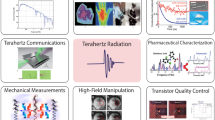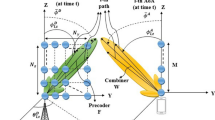Abstract
To reduce high computational cost of existing Direction-Of-Arrival (DOA) estimation techniques within a sparse representation framework, a novel method with low computational complexity is proposed. Firstly, a sparse linear model constructed from the eigenvectors of covariance matrix of array received signals is built. Then based on the FOCal Underdetermined System Solver (FOCUSS) algorithm, a sparse solution finding algorithm to solve the model is developed. Compared with other state-of-the-art methods using a sparse representation, our approach also can resolve closely and highly correlated sources without a priori knowledge of the number of sources. However, our method has lower computational complexity and performs better in low Signal-to-Noise Ratio (SNR). Lastly, the performance of the proposed method is illustrated by computer simulations.
Similar content being viewed by others
References
H. Krim and M. Viberg. Two decades of array signal processing research: The parametric approach. IEEE Signal Processing Magazine, 13(1996)4, 67–94.
D. Malioutov, M. Çetin, and A. Willsky. A Sparse Signal Reconstruction Perspective for DOA estimation with Sensor Arrays. IEEE Transactions on Signal Processing, 53(2005)8, 3010–3022.
G. Karabulut, T. Kurt, and A. Yongaçoĝlu. Estimation of directions of arrival by matching pursuit (EDAMP). EURASIP Journal of Wireless Communications and Networking, 2005(2005)2, 197–205.
S. Cotter, B. Rao, K. Engan, et al. Sparse solutions to linear inverse problems with multiple measurement vectors. IEEE Transactions on Signal Processing, 53(2005)7, 2477–2488.
D. Model and M. Zibulevsky. Signal reconstruction in sensor arrays using sparse representations. Elsevier Signal Processing, 86(2006)1, 624–638.
X. Guo, Q. Wan, C. Chang, et al. DOA estimation using a sparse representation framework to achieve superresolution. Multidimensional Systems and Signal Processing, 21(2010)4, 391–402.
M. Hyder and K. Mahata. Direction-of-arrival estimation using a mixed l 2,0 norm approximation. IEEE Transactions on Signal Processing, 58(2010)9, 4646–4655.
I. Gorodnitsky and B. Rao. Sparse signal reconstruction from limited data using FOCUSS: a re-weighted minimum norm algorithm. IEEE Transactions on Signal Processing, 45(1997)3, 600–616.
A. Cadzow, S. Kim, and C. Shiue. General direction-of-arrival estimation: a signal subspace approach. IEEE Transactions on Aerospace and Electronic Systems, 25(1989)1, 31–47.
A. Bruckstein, D. Donoho, and M. Elad. From sparse solution of system of equations to sparse modeling of signals and image. SIAM Review, 51(2009)1, 34–81.
J. Tropp and S. Wright. Computational methods for sparse solution of linear inverse problem. Proceedings of the IEEE, 98(2010)6, 948–958.
D. Needell and J. Tropp. CoSaMP: Iterative signal recovery from incomplete and inaccurate samples. Applied and Computational Harmonic Analysis, 26 (2009)3, 301–321.
S. Chen, D. Donoho, and M. Saunders. Atomic decomposition by basis pursuit. SIAM Review, 20(2001) 1, 33–61.
R. Chartrand. Exact reconstruction of sparse signals via nonconvex minimization. IEEE Signal Processing Letters, 14(2007)10, 707–710.
C. Austin, R. Moses, J. Ash, et al. On the relation between sparse reconstruction and parameter estimation with model order selection. IEEE Journal of Selected Topics in Signal Processing, 4(2010)3, 560–570.
R. Giryes, M. Elad, and Y. Eldar. The projected GSURE for automatic parameter tuning in iterative shrinkage methods. Applied and Computational Harmonic Analysis, 30(2011)3, 407–422.
Author information
Authors and Affiliations
Corresponding author
Additional information
Supported by the National Natural Science Foundation of China (No. 60502040) and the Innovation Foundation for Outstanding Postgraduates in the Electronic Engineering Institute of PLA (No. 2009YB005).
Communication author: Wang Libin, 1984, male, Ph. D. candidate.
About this article
Cite this article
Wang, L., Cui, C. & Li, P. Doa estimation using a sparse linear model based on eigenvectors. J. Electron.(China) 28, 496–502 (2011). https://doi.org/10.1007/s11767-012-0764-4
Received:
Revised:
Published:
Issue Date:
DOI: https://doi.org/10.1007/s11767-012-0764-4
Key words
- Direction-Of-Arrival (DOA) estimation
- Sparse linear model
- Eigen-value decomposition
- Sparse solution finding




